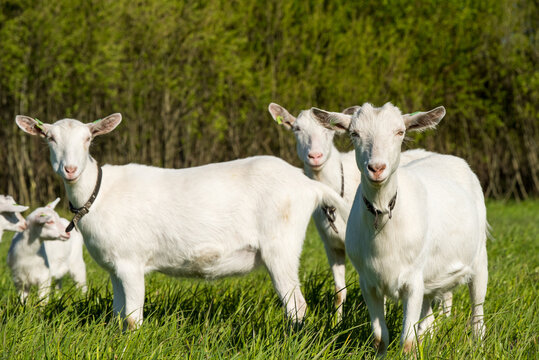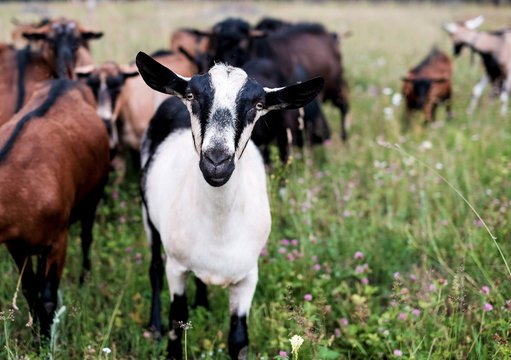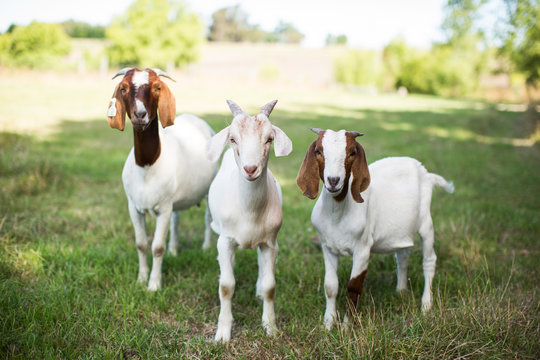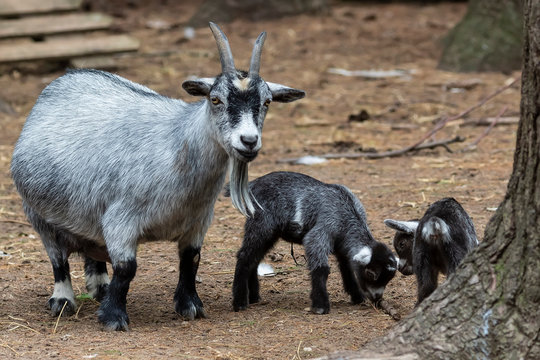If you live off the grid, you need to maximize everything. If one item can serve more than one purpose, the better.
That also holds true for livestock, especially goats. Instead of having two different goat breeds for milk and meat, you can rear a dual-purpose breed.
Dual purpose goats are ideal for both milk and meat production. You also save on the space and feeding grounds, making livestock keeping even simpler.
But if you need dual-purpose goat breeds, which one should you go for?
There are many multi-purpose goat breeds to choose from. This article will describe the best five you can consider. Let’s dive in.
Contents
The Benefits Of Dual-purpose Goat

Dual-purpose goat breeds can give you two products. The most common combination is meat and milk or meat and wool, but most off-gridders prefer goats for both milk and meat.
And that is what we will be discussing in the rest of this article.
The first benefit of a dual-purpose goat breed is that you get two products, milk and meat.
But that doesn’t mean you will be doubling the feeds and care, which brings us to the second advantage.
Dual-purpose goat breeds are economical to keep. You can use the same space and minimal costs to get higher output regarding milk and meat.
That is unlike requiring twice the input if you are to keep two different goat breeds.
A homestead can easily manage to keep a dual-purpose goat in a limited space and tight schedule.
4 Factors To Choose The Right Breed Of Dual Purpose Goat

Choosing the perfect multi-purpose goat can be a challenging task. That is because of the many options available.
However, it can be easy if you carefully consider all possible factors. Generally, your decision will depend on the following:
Size Of Goats
Dual-purpose goat breeds are of different sizes. While this may not seem so significant, it does matter.
Basically, you cannot expect a high yield from small-sized goats. The quantity of meat and milk depends on the size of the goat.
Once again, you also need to consider the size of the goat because it will influence the housing.
If you have already built it, a large breed may not fit. Just think about it before you go for the perfect size.
Regional Climate
Climate is a primary factor when choosing any livestock breed, and goats are no different. They are well-adapted to various climatic conditions.
Some will thrive in cold regions, while others can survive high temperatures and intense summer heat.
Get the general climate trend in your region because it will significantly affect the performance of your goat. Some breeds can even die if not matched to the appropriate climate.
Land/Feed That You Have Available
The size of your land and the quantity of feed available still determines the dual-purpose goat breeds you buy.
Some goats are heavy eaters and require large parcels of land, while others can survive by merely foraging on the fence.
Also, land and your ability to care will determine the number of dual-purpose goats you can keep. Examine this factor to make an informed decision.
Your Time And Money
Do you have the time to care for the goats yourself? And if you have to supplement their feeds, do you have money to buy it?
Dual-purpose goat breeds require proper care and maintenance, which varies from goat breed to the next.
Find dual-purpose goats that are easy to keep and do not take much of your time.
But if you are busy, you can employ someone else to take care of them. Once again, only get the number of goats you can support.
Top 5 Dual Purpose Goats

There are many dual-purpose goats, but we will only give you the best 5 breeds. Many off-gridders prefer keeping either Nubian, Saanen, Sable, Kinder goats, or Pygmy goats.
These breeds have high production and are more resilient to climate. Let’s talk about them in detail.
Nubian
Nubian goats originated from Britain (source). The name, Nubia, was coined in France. It referred to the area along the River Nile from Egypt to Sudan.
Nubian goats emerged in the 19th century when British goats were crossed by the imported ones from India and the eastern Mediterranean.
Nubian goats are very distinctive in appearance, featuring long, wide, drooping ears. They also have a broad forehead, long legs, a convex nose, a flat body, and a short, shining coat.
These characteristics make them well adapted to hot climates in low humidity areas.
This breed comes in different coat colors, including chestnut, black, tan, white, pale, and mottles.
They require more space than most goat breeds but can adapt well to a new environment. If building a shelter, ensure it is dry, warm, and well ventilated.
Nubian goats can breed throughout the year. They are very fertile and have high milk and meat production.
Does weigh 243 pounds and produces 6.6 pounds of milk on average per day. The fat content is about 4.9%, and the protein is 3.8%.
Bucks can weigh as much as 309 pounds. Their large size makes them the best for meat. However, the production of male and female Nubian goats is significantly influenced by feeding and climate.
Despite the large size, Nubian goats are friendly and can double up as pets, especially when they are young. But they are also known for loud noises and stubbornness.
Pygmy Goats

Pygmy goats were originally called Cameroonian Dwarf Goats. As the name suggests, they came from Cameroon in Western Africa.
The first recorded importation into the United States was in 1959. Today, their population is high, and they are commonly found in zoos.
Pygmy goats are the best choice for homesteaders with limited space. But despite the small size, Pygmy goats produce as much milk as many other big-size goat breeds.
Does can produce 4.2 pounds of milk every day on average, with between 4.5-11% butterfat content.
Does weigh about 35-50 pounds, while bucks weigh 40-60 pounds. Pigmy goats have muscular physiques, making them ideal goat breeds for meat.
They come in different colors, such as red caramel, silver, white caramel, and other shades.
Pigmy Goats are docile and intelligent. They are friendly and make good pets for kids and adults. Additionally, they are easy to keep and can forage on the weeds on the property.
Also, Pygmy Goats are more resilient to parasites and disease and require minimal feeding. Handling and transporting them is also easy.
Hantop 3L Goat Milking Machine
- Pulsation System: To prevent damage or pain to the teats that would be caused by the continuous vacuum. Pulsation system makes the liners collapse on and below the teats about once each second massaging the teat and maintaining normal blood flow
- Time & Labor-Saving: Pulsation cycle is 40 times per minute, using a milking machine saves about one-half the labor and time. No need to tolerate sweated in summer or hand stiffed in winter
- Health & Safety: Each part of the milking machine was selected the high standard materials, food-grade Silicone Hose, Teat cup liner and HDPE Milk Container, Healthy and environmentally friendly, non-toxic and tasteless
Kinder Goats
Kinder goats are native to America. They originated from a farm in Snohomish, Washington, in 1985 when an American Pygmy male was mated with a Nubian female.
This selective breeding resulted in a well-muscled goat with high milk production.
Kinder goats are medium in size and come in different coat colors. Does can only grow to 20 inches high and weigh 120 pounds, while bucks reach 28 inches and weigh 150 pounds.
They are distinguished from other goat breeds with their ears that stick out from the head.
Kinder goats are highly productive. You can milk about 5 pounds from one doe per day.
Unlike other goat breeds on this list, Kinder goats have the creamiest milk. The butterfat content hits an all-time high of 7%.
The goats are easy to handle due to their easy going nature. They are the ideal choice for homesteaders who want both milk and meat.
Kinder goats can graze on the property, foraging weeds, shrubs, and brush. Nothing much is needed in care and maintenance.
Saanen

The Saanen goats originated from Saanen valley, Switzerland, and are mainly known for their high milk production.
However, they can also produce high-quality meat. The breed is also consistent in milk production.
If you are a homesteader with a large family, Saanen may be your best choice. The milk will be enough for the entire family.
You can expect a minimum of 12 pounds of milk with 3-4% butterfat content every day.
Saanens are usually white, with some having a few spots in the nose, ears, and udder. They are big in size, with long legs, straight upward ears, and short legs. Many of them are horned.
A mature buck can weigh up to 200 pounds while doe can only reach 160 pounds.
Saanens are heavy eaters that require supplementary feeds to their usual foraging. And that is necessary if you need high milk production.
There should also be a constant supply of fresh, clean water. These goats also need shady conditions because they cannot tolerate high summer heat.
The breed is sweet and friendly. Even kids can raise them on the property.
Sable
Sable goats originated from New Zealand, where they were developed from Saanen. They resemble Saanen in many ways, except that they come in multiple colors.
If not for the coat color, differentiating Sables from Saanens becomes challenging. They are medium-sized with long legs, upright ears, and a fine, short coat.
Overall, sable goats are tall, heavy, and rangy. Bucks can reach a height of 32 inches, while does manage 30 inches. Overall, the bodyweight of Sable goats is 143 pounds.
Sables are excellent grazers, making them the best choice for homesteaders. Their maintenance cost is low.
But you can also supplement their diet with quality feeds for high milk and meat production. Does produce about 4-9 pounds of milk with 3-4% butter content.
Sables are resilient goat breeds that can thrive well in hot and sunny areas. They are also not susceptible to skin cancer like Saanens.
If you are looking for a calm, docile, and friendly dual-purpose goat breed, Sables are the best choice.
However, you should not leave them with kids in the field. They usually wander around looking for greener and leafier plants.
Manna Pro Goat Mineral | Made with Viatimins & Minerals to Support Growth
- FORTIFIED: Manna Pro Goat Mineral is fortified with minerals and vitamins to support sound growth, reproduction, and show appearance. Can be fed to all classes of goats.
- AMMONIUM CHLORIDE: Goat Mineral contains ammonium chloride to help prevent the occurrence of urinary calculi
- ABSORPTION: Goat Mineral contains chelated minerals help ensure absorption and utilization
Conclusion
A dual-purpose goat breed is a must-have for homesteaders, especially those with limited space.
If you choose the right one, you can have enough milk and meat for your family with minimal input. Just use the information provided here to make an appropriate decision.
Thank you for reading our article. The Em Offgrid appreciates your time and gladly invites you to explore the site for more related articles.
Also read:
- 6 Heritage Goat Breeds
- 10 Best Homestead Animals (Chicken, Rabbits, Ducks And Mores)
- The 5 Best Livestock For Off-Grid Living


